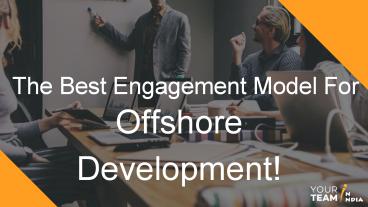The Best engagement model for offshore development - PowerPoint PPT Presentation
Title:
The Best engagement model for offshore development
Description:
Planning to develop your product/software offshore? Don't know which outsourcing model to choose? Check this post & find out which type of engagement model will fit best for your business! – PowerPoint PPT presentation
Number of Views:267
Title: The Best engagement model for offshore development
1
The Best Engagement Model For
Offshore Development!
2
OUR DISCUSSION TODAY!
TOPICS AND HIGHLIGHTS
1. A Short Introduction 2. Types of
Outsourcing 3. Dedicated Team Model 4. Time and
Materials Model 5. Fixed Price Model 6. Conclusion
3
A SHORT INTRODUCTION
IT Outsourcing is a great business strategy that
can help entrepreneurs save up to 70 of the
development cost. Apart than cost-benefits,
outsourcing allows you to scale your business,
focus on your core business activities offer
round the clock service to your customers. While
outsourcing, entrepreneurs often find themselves
amidst great confusion in finalizing the
engagement model for offshore development.
Therefore, its required to study all the aspects
carefully, before making any decision.
4
TYPES OF OUTSOURCING
Onshore Outsourcing
Nearshore Outsourcing
Offshore Outsourcing
It is the type of outsourcing where a company
hires another company within the same country.
It is the type of outsourcing where a company
hires a team of experts from a neighbor country.
In this type a company hires another company,
regardless of the location, to save the cost.
TYPES OF OUTSOURCING
5
ENGAGEMENT MODEL
An engagement model defines the type of
collaboration between a client and an outsourcing
partner. The type of engagement model you are
using determines the level of control
responsibility over the entire process. There are
three types of engagment model 1. Dedicated
Team Model 2. Time and Materials Model 3. Fixed
Price Model
6
DEDICATED TEAM MODEL
This type of model is beneficial for long-term
projects where requirements are dynamic. Lets
take an example. Assume you are an app
development company in the USA your in-house
team lacks the expertise to develop complex
applications. Its clear that hiring a team of
professionals in your country would require you
to empty your pockets. On the other hand, an
experienced team of mobile app developers in a
country like India will get things done for you
at 70 less cost.
7
ADVANTAGES
8
TIME MATERIAL MODEL
This IT outsourcing model deals with payment on
the basis of effort time spent by the team. In
this model, your requirements budget should be
precisely defined. Lets continue with the
previous example considering that your hired
resource is working on your mobile app
encounters an issue. Now, based on this model the
expected time work will exceed the numbers
initially decided. Consequently, you will have to
pay more to your developer or development team.
9
ADVANTAGES
10
FIXED PRICE MODEL
In the fixed price model, all risks are taken by
the hired resource. And the client prefers this
model the most as he gets the opportunity to pay
once the work is complete or the client is
satisfied. This type of model is useful for
short/medium sized projects. As a matter of fact,
this engagement model works best for small
projects with limited scope budget.
11
ADVANTAGES
12
CONCLUSION
Coming back to the question - Which engagement
model is best for your business? Well, every
model has its own advantages disadvantages.
Therefore, if you have a short term project, it
would be a wise decision to choose the time and
material model. Whereas, if you have a long term
project with fixed requirements budget, the
fixed-cost model is the best. In case of a long
term project with no fixed requirements,
dedicated team model will suit your business
requirements.
13
CONTACT US

